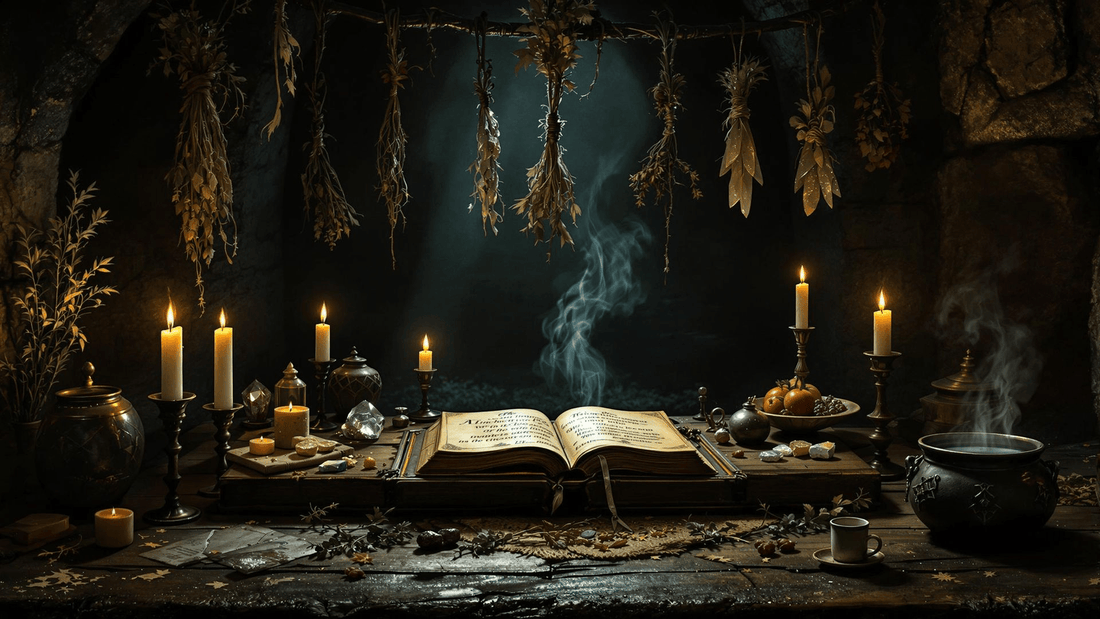
Witches' Altars Demystified
Share
I. Understanding Witches' Altars
Witches' altars serve as sacred spaces in witchcraft, offering a focal point for rituals, spiritual workings, and connecting with the divine. These altars reflect the practitioner’s beliefs and are adorned with meaningful tools, symbols, and offerings. They are spaces to commune with nature, the energies around us, and the spiritual world. Over time, attitudes toward witchcraft and altars have shifted dramatically. Historically stigmatized as linked to dark forces, altars have also been revered as sites of healing, empowerment, and sacred knowledge. Early altars often included natural items like stones, soil, water, and living trees. Some traditions even included sacrificial practices, though modern altars tend to emphasize personal growth and spiritual exploration.
In this article, we’ll delve into the history and evolution of witches' altars, exploring their ancient roots, components, and how they have been reimagined in contemporary practices. We’ll uncover how these sacred spaces weave together tradition, personal expression, and the broader tapestry of spiritual practice, bridging past and present.
II. Historical Roots of Witches' Altars
A. Ancient Rituals and Methods
The origins of witches' altars trace back to ancient civilizations, where sacred spaces were created for spiritual and ritualistic purposes. Altars were central to religious practices and often located in nature—groves, mountains, and near water. Ancient Egyptians offered food, incense, and symbolic artifacts at altars dedicated to deities, while Celtic cultures used stone or clay altars in rituals deeply connected to natural and elemental forces. These early practices laid the foundation for what we now recognize as witches' altars, serving as spaces to bridge the spiritual and physical realms.
B. Altars During the Middle Ages
The Middle Ages brought significant changes to witchcraft and the perception of altars. Witchcraft, often misunderstood and feared, was linked to heresy and dark arts. Altars became hidden, secret spaces where practitioners could connect with their craft away from prying eyes. These altars were adorned with herbs, crystals, candles, and personal items significant to the practitioner. They served not only as functional spaces but also as a reflection of the practitioner’s inner world and a bridge to the spiritual realm.
C. Folklore, Mythology, and Altars
Folklore and mythology heavily influenced the narrative surrounding witches and their altars. Stories of witches depicted altars as places of transformation, divination, healing, and spellcasting. Common symbols, such as cauldrons and broomsticks, became intertwined with the imagery of altars. As cultural beliefs around magic and spirituality evolved, so did the interpretations of altars. They transitioned from sacred sites of reverence to symbols of both persecution and empowerment within the context of witchcraft.
III. Components of Witches' Altars
Witches' altars are deeply personal spaces, blending elements of ritual, meditation, and spirituality. While individual practices and cultural contexts influence their appearance, many common elements appear across traditions.
A. Essential Elements of Altars
- Candles: Representing the elements or specific intentions (e.g., green for prosperity, red for love).
- Crystals and Stones: Chosen for their metaphysical properties, such as amethyst for protection or rose quartz for love.
- Herbs and Botanicals: Sage, lavender, and rosemary are popular for their cleansing and magical associations.
- Images and Statues: Representing deities, ancestors, or personal totems.
- Ritual Tools: Items like athames (ritual knives), chalices, and wands, each symbolizing aspects of the practitioner’s intentions.
B. Types of Altars
- Elemental Altars: Representing earth, air, fire, and water for balance.
- Seasonal Altars: Reflecting the changing seasons or marking festivals like Samhain and Beltane.
- Personal Altars: Unique to the practitioner’s spiritual path and life experiences.
- Group Altars: Created for communal rituals, emphasizing shared beliefs and intentions.
C. Personalization and Evolution
Altars are as unique as the individuals who create them. Practitioners often incorporate personal items, such as heirlooms or mementos, to imbue their altar with deeper meaning. Altars are not static—they evolve with the practitioner’s journey, reflecting growth, shifting intentions, and new discoveries.
IV. Contemporary Witches' Altars
A. Modern Witchcraft and Spirituality
In recent years, witchcraft has experienced a renaissance, influencing the way altars are perceived and used. Today, altars are personal sanctuaries for ritual, meditation, and connecting with nature and the divine. Modern practitioners draw from diverse influences, creating altars that blend traditional and contemporary elements.
B. Community and Connection
Altars play a vital role in modern witchcraft communities, both online and offline. They serve as focal points for group rituals, workshops, and shared experiences. Social media platforms have further amplified this connection, allowing practitioners to share altar designs and practices, fostering a sense of community and collaboration.
C. Reviving Ancient Practices
Many contemporary witches honor the past by incorporating historical traditions and ancestral practices into their altars. This revival enriches modern witchcraft, blending ancient wisdom with modern interpretations.
V. Conclusion
Witches' altars are more than just sacred spaces; they are living expressions of spirituality, creativity, and connection. From their ancient roots to their modern resurgence, altars have served as places of transformation, empowerment, and communion. Whether adorned with crystals and candles or imbued with deeply personal meaning, witches' altars remain a testament to the enduring power of spiritual practice. By understanding their history and purpose, we honor the traditions that have shaped them and the practitioners who continue to evolve them.
Interested to learn more in one of our altar making mini courses?! Join our mailing list to get 10 percent off your first purchase and be the first to know about our retreats, events and other special offers!
